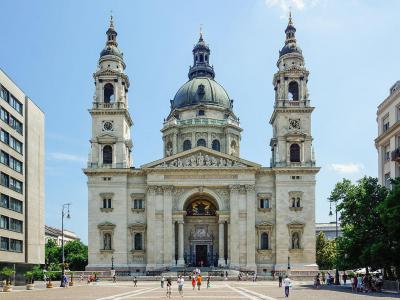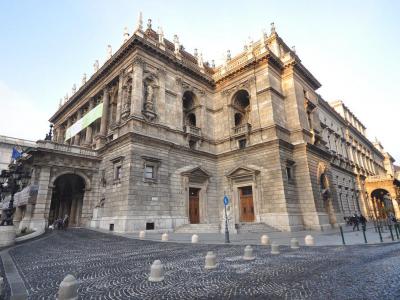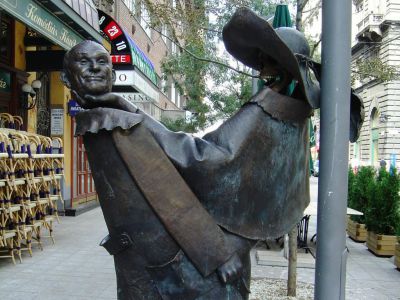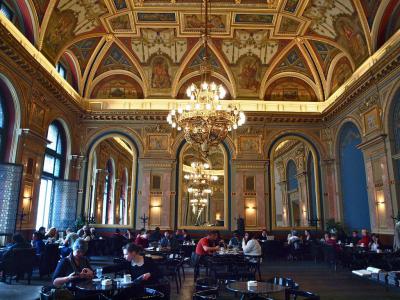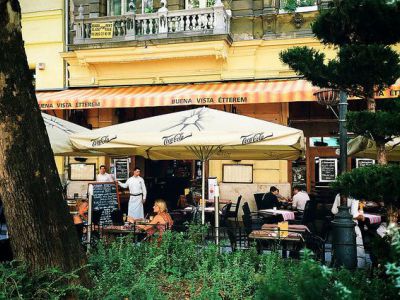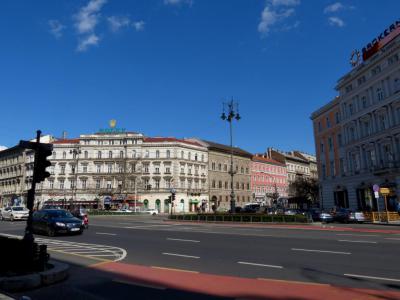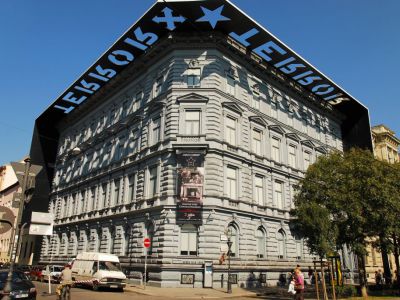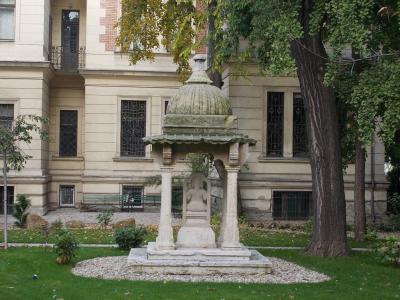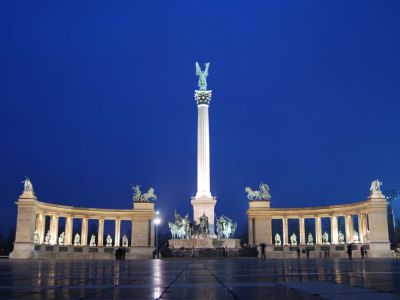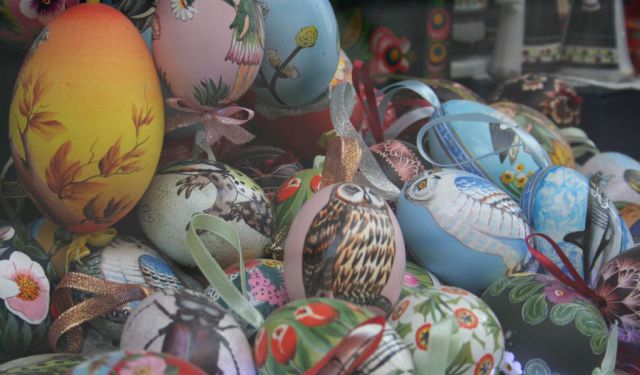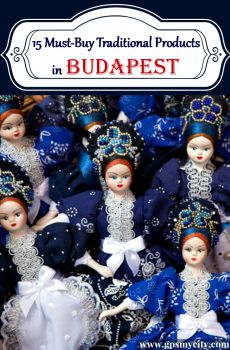Andrassy Avenue Walking Tour (Self Guided), Budapest
Dating back to 1870 and recognized as a World Heritage site, Andrássy Avenue is a long, wide boulevard named after Prime Minister Gyula Andrássy (served 1867–71) that connects Budapest's downtown with the City Park. The entire stretch is lined with cafés, restaurants, luxury shops, as well as cultural institutions, elegant neo-Renaissance apartment blocks, mansions, and embassies with harmonious stone facades, all making for an eclectic mix of the new and old.
Begin your exploration near the beautiful Danube river and Erzsébet Square with a visit to one of downtown Budapest’s landmark buildings – St. Stephen’s Basilica. The relics, the small museum, the organ and the city views from the top make it a must-see even for non-religious people.
Among other key sights are the State Opera House (drop in whenever the box office is open to admire the ostentatious lobby); the fully restored Lotz Hall housing an excellent café with tinkling-piano ambience and reasonable prices; the House of Terror Museum, which powerfully documents previous terror regimes; and the Museum of Asiatic Arts with more than 30,000 pieces originating from South East Asia, Japan, China, India, etc.
If you like the “Broadway Quarter” near the Opera House, you’ll find a similar energy in Franz Liszt Square, ideal for meetings, short strolls, good coffee, lunch, or dinner.
Take this self-guided walk to explore Budapest’s most famous boulevard, soak in the atmosphere of Budapest’s city center, and end with Heroes’ Square and the City Park at your fingertips!
Begin your exploration near the beautiful Danube river and Erzsébet Square with a visit to one of downtown Budapest’s landmark buildings – St. Stephen’s Basilica. The relics, the small museum, the organ and the city views from the top make it a must-see even for non-religious people.
Among other key sights are the State Opera House (drop in whenever the box office is open to admire the ostentatious lobby); the fully restored Lotz Hall housing an excellent café with tinkling-piano ambience and reasonable prices; the House of Terror Museum, which powerfully documents previous terror regimes; and the Museum of Asiatic Arts with more than 30,000 pieces originating from South East Asia, Japan, China, India, etc.
If you like the “Broadway Quarter” near the Opera House, you’ll find a similar energy in Franz Liszt Square, ideal for meetings, short strolls, good coffee, lunch, or dinner.
Take this self-guided walk to explore Budapest’s most famous boulevard, soak in the atmosphere of Budapest’s city center, and end with Heroes’ Square and the City Park at your fingertips!
How it works: Download the app "GPSmyCity: Walks in 1K+ Cities" from Apple App Store or Google Play Store to your mobile phone or tablet. The app turns your mobile device into a personal tour guide and its built-in GPS navigation functions guide you from one tour stop to next. The app works offline, so no data plan is needed when traveling abroad.
Andrassy Avenue Walking Tour Map
Guide Name: Andrassy Avenue Walking Tour
Guide Location: Hungary » Budapest (See other walking tours in Budapest)
Guide Type: Self-guided Walking Tour (Sightseeing)
# of Attractions: 9
Tour Duration: 2 Hour(s)
Travel Distance: 2.8 Km or 1.7 Miles
Author: DanaOffice
Sight(s) Featured in This Guide:
Guide Location: Hungary » Budapest (See other walking tours in Budapest)
Guide Type: Self-guided Walking Tour (Sightseeing)
# of Attractions: 9
Tour Duration: 2 Hour(s)
Travel Distance: 2.8 Km or 1.7 Miles
Author: DanaOffice
Sight(s) Featured in This Guide:
- St. Stephen's Basilica
- Hungarian State Opera House
- Pest Broadway
- Café Párisi – Lotz Hall
- Franz Liszt Square
- Oktogon
- House of Terror
- Ferenc Hopp Museum of Asiatic Arts
- Heroes' Square
1) St. Stephen's Basilica (must see)
Overlooking its namesake square, Saint Stephen’s Basilica is one of Budapest’s crown jewels-both spiritually and architecturally. Dedicated to King István, Hungary’s first monarch who brought Christianity to the country, the church holds an unusual and revered relic: the king’s mummified right fist, encased in a glass box. Pilgrims from all across Hungary come to see it, although casual visitors might easily walk right past. Also laid to rest here is Ferenc Puskás, the legendary soccer player hailed as one of the greatest in history.
For many Hungarians, Saint Stephen’s is the most important religious site, much as it is a key local attraction for tourists. The building can hold up to 8,500 people at a time and rises 96 meters into the air, matching the height of the Parliament Building-a record legally reserved for Budapest’s most iconic structures.
To create this Neoclassical marvel took the work of three architects, including the renowned Miklós Ybl. Adorned with a bust of Saint István right above the doorway, the facade features a huge arched portal with Ionian columns, flanked on both sides with huge bell towers. Topping the right tower is the heaviest and largest bell in the country, tipping the scales at nine tonnes!
Entry to Saint Stephen's Basilica requires a paid ticket, which grants access to all parts of the building, including the treasury and the dome. Visitors can reach the top by stairs or elevator, where they are rewarded with one of the city's best panoramic views. Inside, the basilica features richly decorated interiors with marble surfaces, gilded details, stained glass windows, and detailed mosaics and frescoes. At the main altar stands a statue of Saint Stephen, surrounded by works from some of Hungary’s most renowned artists.
Another unforgettable highlight here is the grand pipe organ. Music lovers should keep an ear out for concerts-hearing it in action is nothing short of an awe-inspiring experience.
Tip: After visiting, take some time to relax in the square-a great place to enjoy coffee at open-air cafes while soaking up the view.
For many Hungarians, Saint Stephen’s is the most important religious site, much as it is a key local attraction for tourists. The building can hold up to 8,500 people at a time and rises 96 meters into the air, matching the height of the Parliament Building-a record legally reserved for Budapest’s most iconic structures.
To create this Neoclassical marvel took the work of three architects, including the renowned Miklós Ybl. Adorned with a bust of Saint István right above the doorway, the facade features a huge arched portal with Ionian columns, flanked on both sides with huge bell towers. Topping the right tower is the heaviest and largest bell in the country, tipping the scales at nine tonnes!
Entry to Saint Stephen's Basilica requires a paid ticket, which grants access to all parts of the building, including the treasury and the dome. Visitors can reach the top by stairs or elevator, where they are rewarded with one of the city's best panoramic views. Inside, the basilica features richly decorated interiors with marble surfaces, gilded details, stained glass windows, and detailed mosaics and frescoes. At the main altar stands a statue of Saint Stephen, surrounded by works from some of Hungary’s most renowned artists.
Another unforgettable highlight here is the grand pipe organ. Music lovers should keep an ear out for concerts-hearing it in action is nothing short of an awe-inspiring experience.
Tip: After visiting, take some time to relax in the square-a great place to enjoy coffee at open-air cafes while soaking up the view.
2) Hungarian State Opera House
Set at the heart of Pest, on Andrassy Avenue, the Hungarian State Opera was officially opened to the public in 1884. Designed by Miklós Ybl, a key figure of 19th-century Hungarian architecture, this grand and elegant edifice represents a blend of Baroque, Renaissance and Revival styles and took nearly a decade to build, skillfully planted into the ensemble of affluent mansions nearby.
Although nowhere near the world's major concert halls in terms of size, the Hungarian Opera House is definitely one of the most beautiful. Flanking the building's main entrance, inside the niches, are the statues of Ferenc Erkel, author of the Hungarian National Anthem, and Ferenc Liszt, the most acclaimed Hungarian composer and reputedly one of the best pianists of his time. On the balustrade, surrounding the roof, are the 16 statues of Europe's greatest composers, such as Beethoven, Mozart, Verdi, Bizet, Puccini and Tchaikovsky. On the inside, the building is just as grand as it is on the outside, replete with marble columns and staircases, vaulted ceilings and lavish gold plating, complete with a rich chandelier weighing several tons(!), and ornate frescoes depicting scenes from the Greek mythology, not to mention the wealth of finest oil paintings and sculptures to be found in Budapest added to the decoration.
The acoustics here are said to be among the best in the world, ranked #3 in Europe after La Scala in Milan and Palais Garnier in Paris.
If you can't get a ticket or if opera isn't one of your things yet, consider taking a guided tour, run three times a day, to get a sense of what the high-society life in Budapest was like back in its heyday in the late 19th century. The tour will take you to the private balconies, smoking room, royal private staircase, and the bar area lavishly clad in crystal and Croatian marble.
Otherwise, if you're an opera fan, try to book yourself a ticket – if lucky, you just might succeed. The tickets are surprisingly not as pricey as you may think, but still, be prepared to dress up to the nines as it is a rather glamorous affair, after all.
Tip:
Combine with the nearby Mai Manó House of Photography, if only to have a look at the building from the outside.
Editor's note:
The building is being renovated until 2020, therefore Opera House performances temporarily take place at the Erkel Theatre. However, the Opera Shop and certain parts of the building can be visited even during renovation.
Although nowhere near the world's major concert halls in terms of size, the Hungarian Opera House is definitely one of the most beautiful. Flanking the building's main entrance, inside the niches, are the statues of Ferenc Erkel, author of the Hungarian National Anthem, and Ferenc Liszt, the most acclaimed Hungarian composer and reputedly one of the best pianists of his time. On the balustrade, surrounding the roof, are the 16 statues of Europe's greatest composers, such as Beethoven, Mozart, Verdi, Bizet, Puccini and Tchaikovsky. On the inside, the building is just as grand as it is on the outside, replete with marble columns and staircases, vaulted ceilings and lavish gold plating, complete with a rich chandelier weighing several tons(!), and ornate frescoes depicting scenes from the Greek mythology, not to mention the wealth of finest oil paintings and sculptures to be found in Budapest added to the decoration.
The acoustics here are said to be among the best in the world, ranked #3 in Europe after La Scala in Milan and Palais Garnier in Paris.
If you can't get a ticket or if opera isn't one of your things yet, consider taking a guided tour, run three times a day, to get a sense of what the high-society life in Budapest was like back in its heyday in the late 19th century. The tour will take you to the private balconies, smoking room, royal private staircase, and the bar area lavishly clad in crystal and Croatian marble.
Otherwise, if you're an opera fan, try to book yourself a ticket – if lucky, you just might succeed. The tickets are surprisingly not as pricey as you may think, but still, be prepared to dress up to the nines as it is a rather glamorous affair, after all.
Tip:
Combine with the nearby Mai Manó House of Photography, if only to have a look at the building from the outside.
Editor's note:
The building is being renovated until 2020, therefore Opera House performances temporarily take place at the Erkel Theatre. However, the Opera Shop and certain parts of the building can be visited even during renovation.
3) Pest Broadway
Often described as “Champs-Élysées and Broadway rolled into one”, the intersection of Nagymező Street and Andrassy Avenue in Budapest, commonly known as Pest Broadway, is historically renowned for its association with theaters and music. Situated close to the Budapest Opera House, the area is home to the Moulin Rouge nightclub, the Mai Manó House of Photography, the Ernst Gallery, and many other artistically influenced companies the presence of which makes it a cultural center of the city.
Among them are some traditional theaters, like the Thália and Radnóti and the Operetta Theatre, found at the nearby Nagymező Street. A place called Mikroszkóp is famous for its stand-up comedy, attesting to which is a statue of Hungary's most celebrated stand-up comedian, Géza Hofi, placed out front. The surrounding streets, leading toward the Ferenc Liszt Academy of Music, are quite big on the night entertainment. If you care to stroll down a bit in that direction, you will spot many cute sculptures and monuments along the way, as well.
There is a rich choice of fine dining on Pest Broadway too, including gourmet restaurants, quaint cafes and bars dotting the streets and largely contributing to the area's overall popularity with the locals and tourists alike.
Among them are some traditional theaters, like the Thália and Radnóti and the Operetta Theatre, found at the nearby Nagymező Street. A place called Mikroszkóp is famous for its stand-up comedy, attesting to which is a statue of Hungary's most celebrated stand-up comedian, Géza Hofi, placed out front. The surrounding streets, leading toward the Ferenc Liszt Academy of Music, are quite big on the night entertainment. If you care to stroll down a bit in that direction, you will spot many cute sculptures and monuments along the way, as well.
There is a rich choice of fine dining on Pest Broadway too, including gourmet restaurants, quaint cafes and bars dotting the streets and largely contributing to the area's overall popularity with the locals and tourists alike.
4) Café Párisi – Lotz Hall
One of the jewels of Budapest's illustrious Belle Époque, the 19th-century Lotz Hall – originally a casino – was extensively renovated and transformed into the Art Nouveau-style Paris Department Store (the sign "Párisi Nagy Áruház" is still visible on the façade) at the onset of the 20th century.
With its frescos by Károly Lotz, huge mirrors, golden ornaments and sparkling chandeliers, this opulent hall on Andrássy Avenue now houses the French-style Café Párisi, a magnet for both locals and tourists to spend a quiet hour imbibing the atmosphere whilst drinking coffee or tea, having a slice of cake, and being serenaded by a stunning grand piano. You pay a small premium on the beverages/cakes but the setting makes it worth it.
With its frescos by Károly Lotz, huge mirrors, golden ornaments and sparkling chandeliers, this opulent hall on Andrássy Avenue now houses the French-style Café Párisi, a magnet for both locals and tourists to spend a quiet hour imbibing the atmosphere whilst drinking coffee or tea, having a slice of cake, and being serenaded by a stunning grand piano. You pay a small premium on the beverages/cakes but the setting makes it worth it.
5) Franz Liszt Square
Anchored by the Academy of Music, the Franz List Square is ideal for meetings, short strolls, a great coffee, lunch, or dinner. Popular with locals and tourists alike, especially on summer evenings, this leafy, relaxed pedestrian area is surrounded by restaurants and cafés like the famous Menza (known for its traditional Hungarian favorites and nice wine), the bright, wood-floored Café Vian (praised for its perfect food and service, plus live music), Seasons Bistro (one of Budapest's best kept secrets), Incognito (good for drinks and chill), Korhely faloda és daloda (known to make meat-eaters extremely pleased), etc.
Franz Liszt's statue in the center of the square captures both the essence of the famous composer and the size of his hands, which alludes to his skill on the piano. which allude to his skill on the piano. Unveiled in 1986, it is the work of prize-winning sculptor László Marton, who also sculpted the Little Princess statue on the Danube promenade. Other artworks in the square include a bronze statue to Hungarian poet Endre Ady and a very unusual work dedicated to Sir Georg Solti, a Hungarian-born conductor and a long-serving music director of the Chicago Symphony Orchestra.
On the corner of Andrassy ut 45, there is also a place called the Irok Boltja ("Writer's Bookshop"), where you can find some of the best literary events in Budapest. It is definitely a meeting place for famous and not so famous writers, people who love to read, and even just the curious.
Franz Liszt's statue in the center of the square captures both the essence of the famous composer and the size of his hands, which alludes to his skill on the piano. which allude to his skill on the piano. Unveiled in 1986, it is the work of prize-winning sculptor László Marton, who also sculpted the Little Princess statue on the Danube promenade. Other artworks in the square include a bronze statue to Hungarian poet Endre Ady and a very unusual work dedicated to Sir Georg Solti, a Hungarian-born conductor and a long-serving music director of the Chicago Symphony Orchestra.
On the corner of Andrassy ut 45, there is also a place called the Irok Boltja ("Writer's Bookshop"), where you can find some of the best literary events in Budapest. It is definitely a meeting place for famous and not so famous writers, people who love to read, and even just the curious.
6) Oktogon
One of the busiest junctions in Budapest, the eight-sided Oktogon once rejoiced in the name of Mussolini Square, while under the communist regime it was called November 7 Square after the date of the Bolshevik revolution. Now kids called it the "American Square" as it is surrounded by fast-food chains (McDonald's, TGI Fridays, Starbucks, and the world's largest Burger King), some of which are even open 24/7. Add to these the taxis and buses running non-stop along the Nagykörút through to the wee hours, and you've got yourself a square (and intersection) that hardly ever sleeps.
While here, you may wonder why the Batthyány Mansion (Teréz körút 13) is adorned with wrought iron rings and looks somewhat familiar from architecture books. Apparently, the building is a proportionally reduced copy of the Palazzo Strozzi in Florence, with some details being modified – but even so, "stumbling" upon it is an interesting experience.
Walking on Andrassy Avenue from Oktogon to Heroes' Square is always a pleasure. On this route, many beautiful buildings can be seen, and the atmosphere of Budapest's city center can certainly be felt.
Tip:
If you plan on having a good burger to a medium price, but guaranteed quality, Bamba Marha Burger Bar (11:30am–10pm) is your place to be!
While here, you may wonder why the Batthyány Mansion (Teréz körút 13) is adorned with wrought iron rings and looks somewhat familiar from architecture books. Apparently, the building is a proportionally reduced copy of the Palazzo Strozzi in Florence, with some details being modified – but even so, "stumbling" upon it is an interesting experience.
Walking on Andrassy Avenue from Oktogon to Heroes' Square is always a pleasure. On this route, many beautiful buildings can be seen, and the atmosphere of Budapest's city center can certainly be felt.
Tip:
If you plan on having a good burger to a medium price, but guaranteed quality, Bamba Marha Burger Bar (11:30am–10pm) is your place to be!
7) House of Terror (must see)
A building that chilled hearts during much of the 20th century, the so-called House of Terror stands out against the more traditional buildings on Andrassy Avenue with its black passé partout, granite sidewalks, and blade-colored walls.
It is actually a museum proper, detailing some of the gruesome activities of the German occupation and what followed under the Russian-backed communist government. In like fashion, it is also a memorial to the many who died under the city's "double occupation" or were victims of torture and detention, providing some insight and understanding of the plight of the ordinary Hungarian folk.
The whole experience is atmospheric with music, lighting and video contributing to the ambiance. Most of the information in the museum is in the form of testimonial videos from survivors of the different regimes, coupled with original photos and newsreels/propaganda videos rather than objects (though there are a few around), so it is rather "good value" in terms of how much content one gets for the money. Moreover, each room has a box full of A4 papers in English and Hungarian with a background in what the room relates to (though not necessarily what visitors are looking at exactly).
It is actually a museum proper, detailing some of the gruesome activities of the German occupation and what followed under the Russian-backed communist government. In like fashion, it is also a memorial to the many who died under the city's "double occupation" or were victims of torture and detention, providing some insight and understanding of the plight of the ordinary Hungarian folk.
The whole experience is atmospheric with music, lighting and video contributing to the ambiance. Most of the information in the museum is in the form of testimonial videos from survivors of the different regimes, coupled with original photos and newsreels/propaganda videos rather than objects (though there are a few around), so it is rather "good value" in terms of how much content one gets for the money. Moreover, each room has a box full of A4 papers in English and Hungarian with a background in what the room relates to (though not necessarily what visitors are looking at exactly).
8) Ferenc Hopp Museum of Asiatic Arts
Located near the end of Andrassy Avenue, in the six-room mansion of former 19th-century optician, great traveler, and Asian artifact collector Ferenc Hopp, this museum is a charming place for Oriental art, based on various private collections and donations. It always houses temporary exhibits with different items from all around Asia – including Japanese, Chinese or Indian artifacts – as well as delightful souvenirs. Coat check with lockers, cozy collection rooms, and a marvelous (free to visit) little oriental garden with a lovely moon gate all make this a great little stop if you happen to be strolling by.
9) Heroes' Square (must see)
Heroes' Square is easy to get to, and unforgettable once you've seen it. Located in front of the City Park, at the end of Andrassy Avenue, the monument was built in 1896 to commemorate the millennial anniversary of the arrival of the people of Hungary to the Carpathian Basin. By design, it consists of two semi-circles, which have the symbols for War and Peace, Knowledge and Glory, and Wealth and Labor affixed. The place is decorated with the statues of famous kings, governors, and celebrated characters from Hungarian history, as well as little reliefs depicting the most pinnacle moment of their lives.
The centerpiece of the memorial is the 36-meter high statue of the Archangel Gabriel holding a crown in his right hand and the double cross of Christianity in the other. The base of the column is surrounded by seven equestrian statues of ferocious-looking warriors, which depict the Magyar chieftains of the Hungarian tribes, the most notable being Árpád, whose descendants started the Hungarian royal line.
In front of the Millennium, Column stands the Monument of National Heroes, a cenotaph also referred to as the Tomb of the Unknown Soldier, in tribute to Hungary's nameless heroes of war.
The sheer size of everything means one cannot fail to be impressed! Flanked by two important buildings – the Museum of Fine Arts on the left and the Palace of Art (Kunsthalle) on the right – this is, in fact, one of Budapest's most visited sights.
Tip:
You can easily combine your visit with a stroll to Vajdahunyad Castle, the peaceful park across the road, and the Széchenyi bath building.
The centerpiece of the memorial is the 36-meter high statue of the Archangel Gabriel holding a crown in his right hand and the double cross of Christianity in the other. The base of the column is surrounded by seven equestrian statues of ferocious-looking warriors, which depict the Magyar chieftains of the Hungarian tribes, the most notable being Árpád, whose descendants started the Hungarian royal line.
In front of the Millennium, Column stands the Monument of National Heroes, a cenotaph also referred to as the Tomb of the Unknown Soldier, in tribute to Hungary's nameless heroes of war.
The sheer size of everything means one cannot fail to be impressed! Flanked by two important buildings – the Museum of Fine Arts on the left and the Palace of Art (Kunsthalle) on the right – this is, in fact, one of Budapest's most visited sights.
Tip:
You can easily combine your visit with a stroll to Vajdahunyad Castle, the peaceful park across the road, and the Széchenyi bath building.
Walking Tours in Budapest, Hungary
Create Your Own Walk in Budapest
Creating your own self-guided walk in Budapest is easy and fun. Choose the city attractions that you want to see and a walk route map will be created just for you. You can even set your hotel as the start point of the walk.
Jewish Quarter Walking Tour
Jews were officially allowed to settle in Pest in the early 18th century. By the late 1700s, a small but growing community had taken root, and the 19th century brought rapid urbanization and expansion. The Jewish population soared, with many Jews becoming integral to Budapest’s economic and cultural life.
Following the Nazi occupation in March 1944, they were forced into a ghetto centered in... view more
Tour Duration: 1 Hour(s)
Travel Distance: 1.2 Km or 0.7 Miles
Following the Nazi occupation in March 1944, they were forced into a ghetto centered in... view more
Tour Duration: 1 Hour(s)
Travel Distance: 1.2 Km or 0.7 Miles
Buda Introduction Walking Tour
Hungary’s capital is relatively young, having emerged in the late 19th century after the merger of two neighboring towns-Buda on the western bank of the Danube and Pest on the eastern side. Buda, with its hills and historic character, is home to the grand Hapsburg palace, still exuding the imperial charm of a time when wealth and power reigned.
From the heights of Castle Hill or Gellért Hill... view more
Tour Duration: 2 Hour(s)
Travel Distance: 3.8 Km or 2.4 Miles
From the heights of Castle Hill or Gellért Hill... view more
Tour Duration: 2 Hour(s)
Travel Distance: 3.8 Km or 2.4 Miles
Pest Introduction Walking Tour
Separated from its western neighbor Buda by the wide sweep of the Danube, the eastern side of Budapest takes up almost two-thirds of the city. While Buda rises in hills and castle-topped cliffs, Pest spreads out across a flat plain, buzzing with energy and a rather bourgeois spirit. Some of Hungary’s most iconic landmarks call this side home, including the grand Parliament building itself. No... view more
Tour Duration: 2 Hour(s)
Travel Distance: 4.3 Km or 2.7 Miles
Tour Duration: 2 Hour(s)
Travel Distance: 4.3 Km or 2.7 Miles
Margaret Island Walking Tour
Stretching for around 2.5 km, Margaret Island (“Margit-sziget”) on the river Danube is a popular green oasis / recreational area that serves as Budapest's playground since the 1870s. Flush with beautiful landscaped parks, ancient ruins and various sports facilities, the island can be accessed either by the historical Margaret Bridge on the south or the Arpad Bridge in the north, from... view more
Tour Duration: 1 Hour(s)
Travel Distance: 2.4 Km or 1.5 Miles
Tour Duration: 1 Hour(s)
Travel Distance: 2.4 Km or 1.5 Miles
Souvenir Shopping
It will definitely be a pity to leave Budapest without exploring local specialty shops and bringing home something authentically Hungarian. A large number of the city’s specialty shops are found on Váci Street, a pedestrian thoroughfare that parallels the Danube, extending for more than 15 blocks, with something for every taste and wallet. At its most southerly end, you will find Central Market... view more
Tour Duration: 1 Hour(s)
Travel Distance: 1.4 Km or 0.9 Miles
Tour Duration: 1 Hour(s)
Travel Distance: 1.4 Km or 0.9 Miles
Useful Travel Guides for Planning Your Trip
15 Must Buy Hungarian Things in Budapest
Other than the standalone language and catchy Czardas tune, there's a lot more to memorize Hungary by. Here are some of the things you might want to carry from Budapest to your family and friends back...
The Most Popular Cities
/ view all



